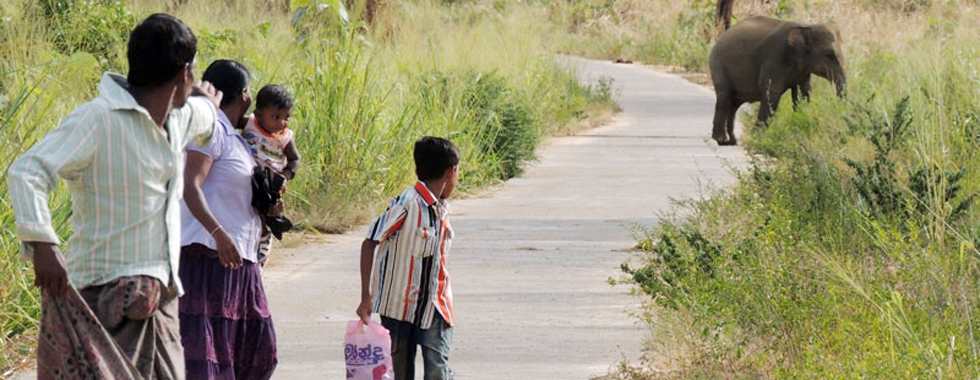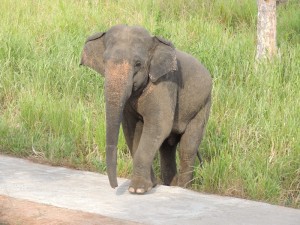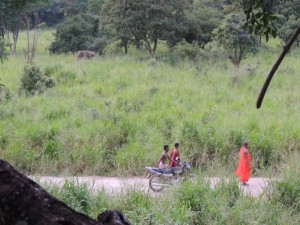The crowded corridor
Every day the rising sun unravels a beautiful scene at the tree hut overlooking the elephant corridor at Wasgamuwa. The sun lights up a serene looking woodland/grassland bordered by hills on one side, jungle on the other and a large irrigation reservoir in the south. Through this corridor elephants and various wildlife range while groups of schoolchildren in white uniforms like peace bearing doves, men and women in colourful clothes and saffron robed monks all pass through on a daily basis. The corridor is vital for the elephants from the Wasgamuwa National Park to access an irrigation tank that is located outside the park for water and food.
A tree hut erected by the Sri Lanka Wildlife Conservation Society (SLWCS) provides an extraordinary window to look upon a tableau that happens practically every day in a landscape that is both used by elephants and people. For nearly twelve years the SLWCS has been monitoring the corridor from the tree hut to gather information on human-elephant interactions. Since that time people and elephants have used the corridor without any untoward incidents.

When their paths cross: VIllagers flee as they spot an elephant
Recently however, matters have begun to take a turn for the worse. With new economic immigrants moving into the region, the increasing population, opening up whatever remaining habitat of elephants outside protected areas for development, disturbances in other parts of the elephants’ range and the lack of a national effort to address human-elephant conflict has resulted in more and more people taking matters into their own hands.
Some people travelling through this corridor, in a mistaken belief that all elephants are dangerous, harass the elephants by making noises, lighting firecrackers and travelling in large and noisy three wheeler convoys to scare them away. Tuk tuks race back and forth along the corridor in a daring show of machismo, their horns shattering the stillness of the jungle and their gaudy lights piercing the darkening night. Most of these drivers are in a heightened state of intoxication as well.
Such behaviour unfortunately makes elephants especially the dominant bulls more aggressive and hostile and prone to attack rather than making them scared of people. School children are highly vulnerable since they have to walk to school and back in the morning and afternoon. On numerous occasions when the situation had reached an impasse because an elephant had become aggressive, the society has helped by transporting people, especially women and children or by escorting safely the various vehicles travelling through the corridor to their villages.
In afternoon in December 2013, Chandima, a field scientist of the SLWCS, as usual left with a group of volunteers to the tree hut in the afternoon. He reached the tree hut around 3.30 p.m.
 When they got there all was quiet. There were no elephants or people in the corridor. After about 10 minutes, a small group of five elephants came from the north side of the corridor and crossing the road started to feed along the western side as they moved towards the irrigation tank in the south. They observed this herd through binoculars, took pictures for individual identification, and notes on their activities.
When they got there all was quiet. There were no elephants or people in the corridor. After about 10 minutes, a small group of five elephants came from the north side of the corridor and crossing the road started to feed along the western side as they moved towards the irrigation tank in the south. They observed this herd through binoculars, took pictures for individual identification, and notes on their activities.
Suddenly, the herd seemed very disturbed and started to walk back fast towards the forest they had come from. Chandima was surprised, as there were no human activities on the corridor and he did not hear any noises or gunshots. But he was sure from the behaviour of the elephants that it was definitely a human disturbance that made them rush back to the forest. The herd did not come back again.
A little later Chandima observed an elephant partly hidden by a patch of scrub standing still very close to the tree hut. It was a lone bull. It didn’t come out but waited by the edge of the forest as if checking the area. After about 15 minutes the bull slowly came out and started to feed 10 metres north of the tree hut.
Soon a motor cycle came from the south of the corridor. There were four men on the bike and they were heading towards the village in the north. Since the elephant was feeding close to the road, Chandima signalled to them about its presence. They continued on without any incident and Chandima recognised two of the riders.
The area was quiet again and the elephant continued to feed leisurely, crossed the road and kept moving as it fed. Then suddenly the same motorbike appeared from the direction of the village travelling very fast. This time there were only two men on the motorbike.
They stopped where the elephant had crossed the road and one of them alighted with a gun and started to walk toward the elephant which was now 50 metres away from the road.
Chandima immediately realised that this man was going to shoot the elephant, because he had been told by villagers that there was supposedly a group responsible for the recent elephant shootings in the area. He shouted to the man from the tree hut, “Hey what are  you going to do? Stop! Stop!” But the man didn’t listen. Then Chandima changed his tone to an appeal and called out, “Malli (younger brother) please don’t do this, you don’t need to do this.”
you going to do? Stop! Stop!” But the man didn’t listen. Then Chandima changed his tone to an appeal and called out, “Malli (younger brother) please don’t do this, you don’t need to do this.”
The man stopped walking and said something to his friend who was standing on the road. He shouted out to Chandima angrily, “What’s the problem? If you want to talk to us then come down from the tree hut.” Chandima replied, “No, I am not coming down, but please don’t shoot the elephant.”
The man with the gun started to walk towards the elephant very fast. Chandima knew then that he was definitely going to shoot the elephant. He shouted again, “I’m begging you Malli, please stop and wait, I’m coming down to talk to you.”
Surprisingly during this altercation the bull had only moved about five metres away from its original position. As Chandima got down from the tree hut the volunteers and visitors with him were all terrified.
Chandima ran towards the men and pleaded with them not to shoot the elephant. He realised he needed to be careful of the words he used and that he had to talk to them in a calm manner. Eventually, the man with the gun came back and he looked very angry. The first thing he told Chandima was to delete all the pictures that he and his friends had taken. To this Chandima had replied that while he could inform the police with the photographic evidence, he was not going to do it, since he wanted to talk with them to provide a solution to whatever the problems they had with elephants.
“You don’t know the difficulties that we face with elephants every day, we can’t get a good harvest from our crops, our incomes are destroyed and we can’t even go to the town because of elephants in the corridor,” the men said. They continued to tell him their grievances with elephants giving several examples. Chandima responded by explaining that shooting elephants was not the solution. By this time they had calmed down and were not as aggressive. Finally they told Chandima, “Because of you, we are not going to kill this elephant, we know about you and the SLWCS, and the work the society had done to help people to protect themselves from elephants.”
After he had convinced the farmers to leave the elephant alone, Chandima told them that the SLWCS would try to speak to the Department of Wildlife Conservation to resolve their problems. The men asked Chandima to speak on their behalf to the Wildlife Department and obtain thunder flashes for farmers to chase elephants from their fields. Chandima had said he would do his best to arrange a meeting with the Wildlife Department to discuss all these issues and concerns.
Chandima had spent over 45 minutes persuading the men not to shoot the bull elephant that evening. The rest of the group in the tree hut had been terribly worried and had even called the field house asking them to come immediately! Chandima says, initially he was afraid too, and that is why he didn’t get down from the tree hut, since the men had a gun and were also under the influence of liquor.
Working for the SLWCS since 2005 this was one of the most unforgettable moments for Chandima. What he did that evening to save the elephant’s life called for fortitude, heroism, passion and caring that surpassed the mere call of duty of a conservationist or of a civic minded individual.
As Chandima and the volunteers left the tree hut, a herd of 15 elephants appeared from the forest. As they drove down the road the bull whose life was saved had come on to the road, perhaps wanting to thank Chandima for saving him from a horrendous death that day!
As a solution to this problem the Sri Lanka Wildlife Conservation Society is now looking into providing the villagers with a bus service -probably the first elephant friendly bus service in the world.
| SLWCS: Living in the conflict
For 18 years the Sri Lanka Wildlife Conservation Society (www.SLWCS.com) has been working in Wasgamuwa to develop measures that would help to turn human-elephant conflict into co-existence. The SLWCS was the first to apply the concept of erecting solar powered electric fences around villages rather than around national parks. The first pioneering fence is still functioning after 18 years. Since the society introduced this concept the Department of Wildlife Conservation, other conservationists and NGOs are using it in their efforts to mitigate human-elephant conflicts. The SLWCS has also been living in the conflict for more than a decade and half observing the damage people and elephants inflict on each other and doing its best to develop measures to address them. |



